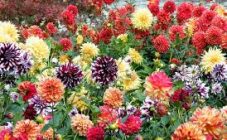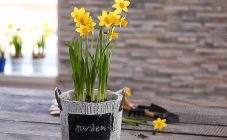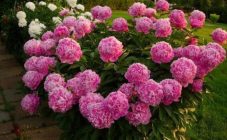Content:
Outdoor dahlias care begins with planting them correctly. Flowers should be planted when recurrent frosts are no longer scary, and the soil has warmed up enough. Basically, experienced gardeners recommend guided by the climatic features of each region.
Care features
So, in Central Russia, these flowers are usually planted already grown and not earlier than June 10. An earlier disembarkation is possible, but several conditions must be met. As soon as the ground warms up reliably, by about May 18, the divided tubers without shoots, but with well-defined eyes, can be lowered into the soil. The sprouts will appear in about 10-15 days. Since frosts are still possible in early spring, young shoots need protection. Even with a slight decrease in temperature, it is better to cover the flowers.
Sometimes it is allowed to plant grown tubers ahead of schedule. But in such cases, you need to stock up on covering material. Moreover, in conditions with a harsh climate, it is better not to practice this method.
In any case, you need to plant the plant in a pre-prepared area, where the stakes are driven in, and the holes are dug. The approximate spacing between flowers should be at least half the height of an adult bush. On average, this value reaches 70 cm. Starting a new row, you will have to retreat at least 1 meter. As for the stakes, they must be strong, more than one and a half meters in height. Often, summer residents use wooden rods as such supports. In this case, it is recommended to choose conifers. They are more durable. You can also extend their service life with special impregnations. But a more practical option is still to use metal stakes. Moreover, it is not at all necessary to buy them in garden stores. Unnecessary pipes or fittings are perfect for this role. The main thing is that their radius is at least 10 mm. The support is driven into the ground 40 cm, then a flower is planted close to it. In this case, you need to generously water the hole. The tuber neck should be 5 cm below ground level. It is recommended to plant in cloudy weather or late in the evening.
When choosing a place for planting flowers, it is necessary to take into account some of their features: a relatively short growing season, the need for a large amount of water, especially at high temperatures, fragility of the stems, requiring protection from strong winds.
In order for the plants to develop correctly and bloom on time, they need to be well looked after. It is important to provide dahlias with adequate moisture. The frequency of watering varies depending on the temperature and humidity of the environment. It is recommended to water the flowers daily for the first 7 days after planting, especially in hot weather. Later, the frequency of irrigation can be reduced, but to reasonable limits, so that the soil under the bush is always moist. It is also necessary to remove weeds and loosen the soil in time. This activity is usually carried out after each watering and fertilization. When the buds are formed, loosening should be stopped. Instead, you need to mulch the ground with peat or humus. In order for a dahlia to grow well, the mulch must be of high quality. This will keep the soil moist for longer, delay the growth of weeds and prevent crusting on the ground.
How to care for dahlias by period
Taking care of dahlias in the garden and at their summer cottage depends on the season. In the cold season, all forces are directed to the correct preparation for the winter and safe storage until the next planting. More details on how to care for dahlias in the country in autumn and winter will be described in another section of the article. Here it is worth dwelling in detail on the spring and summer periods.
Dahlia bushes need moisture. The soil, like the air, should not be dry. For irrigation, it is recommended to use fine sprinklers and irrigate for at least 15 minutes. For this plant will thank you with lush flowering.
When the dahlia takes root, you will need to fertilize with organic and mineral fertilizers. Cow and bird droppings are introduced at the rate of 1:10. To them add 15 g of potassium or ammonium nitrate, the same amount of potassium sulfate and superphosphate. Grooves are made around each flower, up to 6 cm deep, and fertilizers are poured into them. 10 liters of the mixture should be enough for 5 bushes. This feeding is carried out every 2 weeks until mid-summer. After each time, the plants are watered abundantly.
Starting from mid-July, potash-phosphorus fertilizers are applied. 15 g of potassium sulfate and the same amount of potassium nitrate, plus fifty grams of superphosphate, are diluted into 10 liters of water. So until the second half of August.
By the end of summer, more phosphorus should be added to the soil. Without this element, together with potassium and a sufficient amount of water, the outflow of carbohydrates from the stem and leaves of the plant into the tubers occurs slowly and not fully.
Throughout the warm season, in addition to watering and fertilizing, it is necessary to weed the site, loosen the soil, pinch the lateral shoots from the axillary buds, remove the lateral shoots of the peduncle.
If the dahlia has a powerful vegetative system, then it is better to cut off the lower leaves at a distance of 35 cm from the ground. This will improve the flow of air to the roots and prevent overgrowth of the stem. Consequently, the root tuber will be less prone to decay.
What is applicable in care
Nowadays, undersized dahlias grown from seeds are becoming more and more popular. Such annual crops do not need a garter; if desired, you can even grow them at home in a pot. But connoisseurs of tall varieties of this flower should know how to tie dahlias. This plant looks great against the background of a wrought-iron fence or original stakes-supports. The latter mainly need to be strong and reliable in order to protect the dahlias from breaking in the wind or increasing their own weight. For these purposes, metal structures or specialized flower supports are well suited.
Many are interested in the question of how to tie up dahlias so that they do not fall. Usually they begin to do this when the height of the stem reaches 60 cm. You can fix the entire bush as a whole or each shoot separately. In any case, the longest stem is always tied in two places.
To make a homemade dahlia look neat and well-groomed, it must be trimmed. Moreover, it is better to start the procedure when the shoots have just begun to grow. It is required to leave 3-4 of the strongest shoots, and remove the rest. This will be enough for a gorgeous bush. Until it grows to 40 cm, all lateral shoots must also be removed. They unnecessarily thicken the plant and inhibit flowering.
For more inflorescences, it is recommended to pinch the main shoot over 4 pairs of leaves. Otherwise, the dahlia will use all its strength to form one strong bud with seeds.
Dahlias are susceptible to disease and often suffer from pests. Every gardener needs to have in his arsenal of tools to combat these troubles. If the plant is affected by powdery mildew or a viral mosaic, then spots and yellowing will appear on the leaves.Other symptoms include abnormally low growth of the bush, unnatural color of the leaves, and a short peduncle. If such characteristics are found on a flower, the best solution would be to dig it up along with a large clod of earth and burn it. Do the same with tubers if atypical formations are found on them during autumn harvesting. They indicate bacterial cancer.
In case of damage by a slobbering penny or flower beetles, dahlias are sprayed with urea or mullein.
How to cut a plant
One of the popular questions remains how to cut dahlias. Starting in February, the process becomes possible. But the optimal period is still in March-April, when daylight hours increase. This breeding method is considered one of the best for valuable flower varieties, especially if there are not so many tubers. Subject to the rules, up to 50 cuttings can be removed from one root tuber. In addition, a significant rejuvenation of culture will take place.
For the grafting process, you should choose the healthiest and strongest tubers. First you need to disinfect them and leave them to dry in a bright place until the buds appear.
Then the roots are placed in a box and covered with earth mixed with sand and humus. A tuber with an open root collar will produce more cuttings. At first, the ambient temperature will have to be maintained at + 25 ° C. When growth appears, this value can be lowered to +18. With a small amount of natural light, phytolamps will need to be used to grow strong cuttings, at least 3 mm in diameter. A month later, 10-centimeter shoots can be taken for cuttings.
For picking, it is necessary to prepare boxes, the height of the sides of which is 10 cm. They fill them with soil with sand and peat. To protect dahlias from possible diseases, the soil is disinfected with biological agents. Then watered, covered with foil and left for 2 weeks. After this period, the cuttings can be planted.
Preparing for winter
In order for perennials to winter well, they need to be prepared in the fall. First you need to clean up the area where the dahlias grow. Remove all debris, branches, weeds, so that there is nothing left that can serve as a repository for infections, bacteria, etc.
Then you need to carefully examine all the bushes for damage and disease. All frail, lethargic and non-viable plants will need to be selected, dug out with a large clod of earth and preferably burned so that they do not infect healthy flowers. Care must also be taken when examining.
Watering in the autumn months is of great importance for dahlias. This flower stores moisture in the lower three internodes of the stem. Therefore, if you start to dig up a plant immediately after irrigation, it will most likely start to rot. To avoid such a nuisance, it is recommended to stop watering 14 days before the expected harvest of dahlias.
Experienced flower growers recommend not rushing about digging. A hardened plant tolerates winter more easily, so the longer the flowers stand in the garden, the better. But you shouldn't overexpose either. The optimal time is the last days of September or the first week of October.
First, the stem is cut so that a small stump remains. Then, stepping back 35 cm in a circle from the root, they begin to dig up the tuber. After washing the latter, it is left to dry in a dry, well-ventilated place for 5-7 days. After this period, the roots must be processed for better keeping quality. The stems are shortened by another 3 cm. All small roots and uterine tubers are removed so that they do not take away nutrients.
When all these manipulations are completed, you can postpone the tubers for winter storage. They usually hibernate in basements at temperatures no higher than +6 degrees. Boxes filled with sawdust, sand or earth are excellent for this purpose. It is important not to forget to ventilate the room to avoid rotting tubers. If there is no way to store roots in the basement, a dark cabinet in the house or a balcony will do. The main thing is that the room temperature does not exceed +15 degrees.
Dahlias, cared for responsibly, will bloom for a long time and magnificently, pleasing the eye not only of the owners, but also of neighbors and passers-by.

















